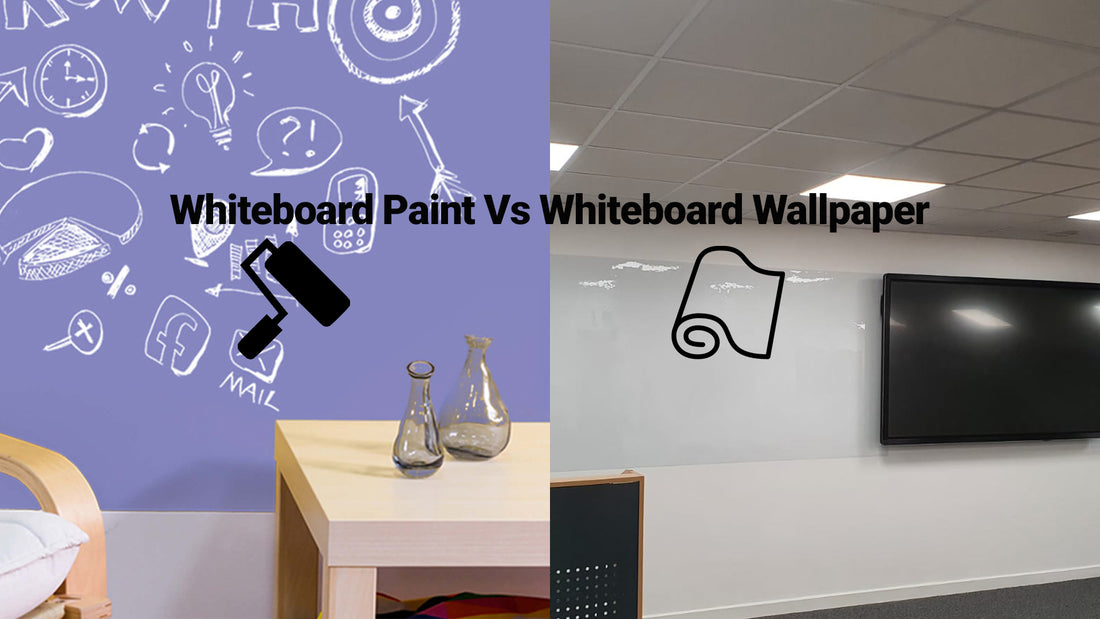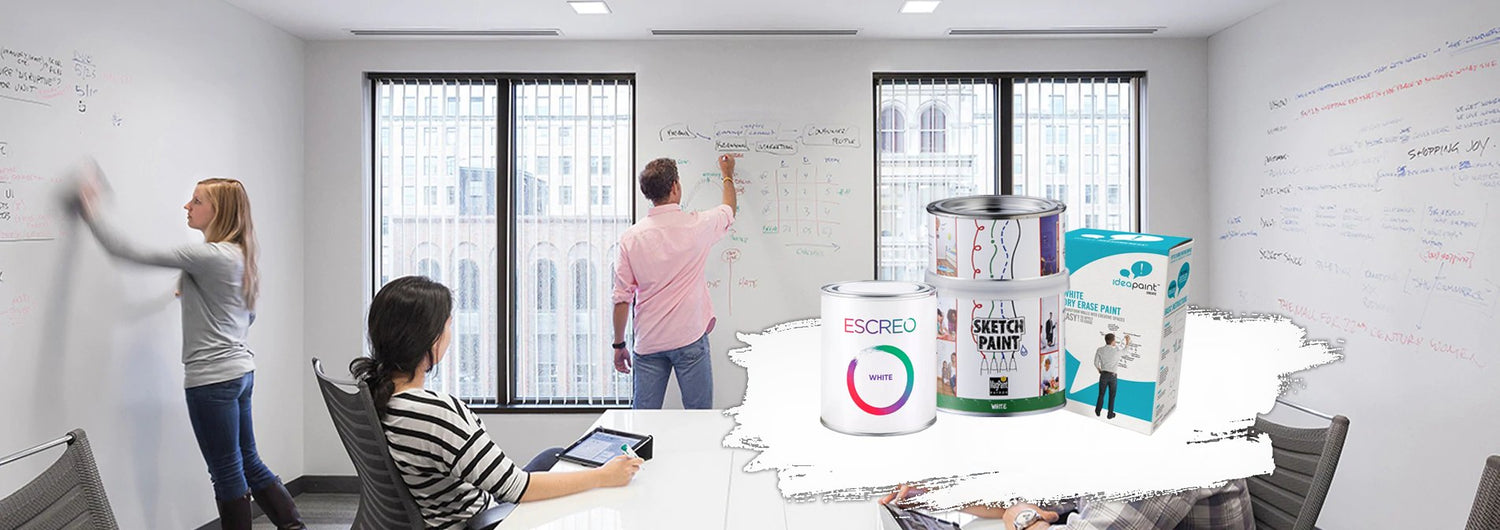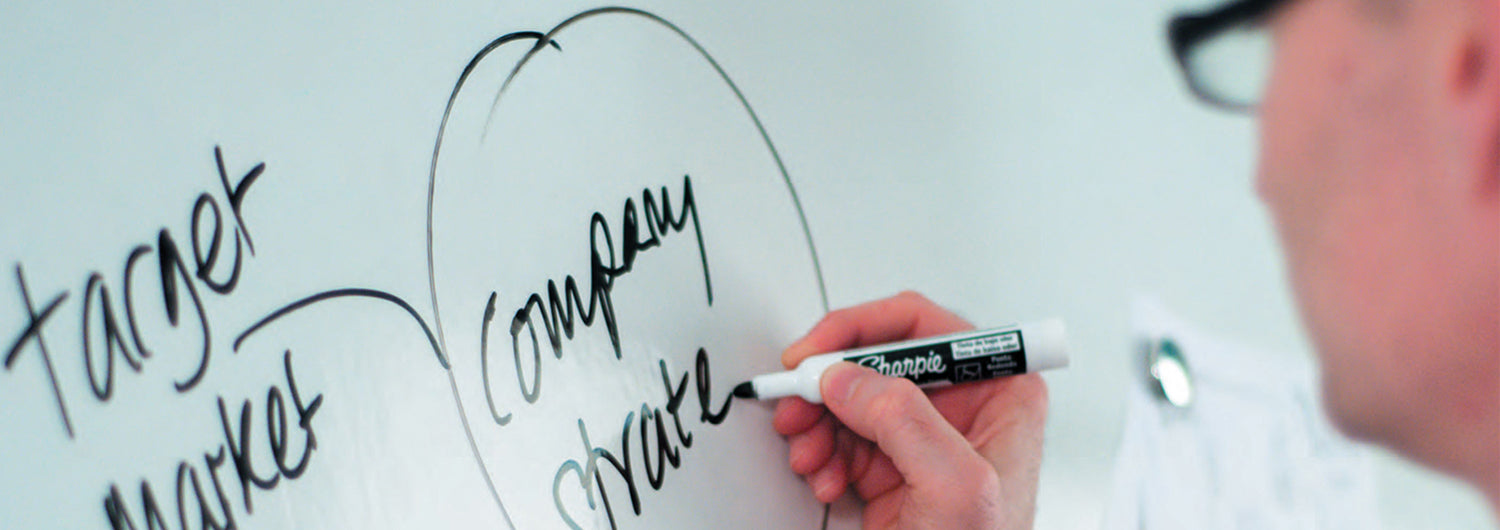Write on, Wipe off, and stick with magnetic attachments.
Both options offer a modern flexible approach and allow you to create large whiteboard walls or cover tricky sizes or shapes. You can even cover table tops or furniture to create something really unique. Anywhere you want a scribble surface.
So how do you know which one is best for you? Ultimately, the choice between whiteboard paint and whiteboard wallpaper depends on your specific needs and preferences, as well as factors like installation ease and durability. Consider the surface you want to convert into a whiteboard, the aesthetics you desire, and how long you plan to use it when making your decision.
| WHITEBOARD PAINT | WHITEBOARD WALLPAPER | |
| Wall Size | Normally more cost effective for smaller areas (less than 1.2m high x 4m wide) | More cost effective where you have a number of walls or a larger surface area to create |
| Join Lines | Best option if you are willing to pay a premium for no join lines | If the area is larger than the standard roll size (1.2m high or 10m wide) you will need to join sections together to cover the area which will create join lines |
| Magnetic Properties | Pair whiteboard paint with magentic primer or paint for a magnetically receptive display | Products already come as magnetically receptive so no need for additional product or installation |
| Time is of the essence | Paint products need a few days to cure before they can be used as a writable surface | Whiteboard wallpaper products are fast to apply and can be used immediately. Best if time is of the essence. |
| Colour Finish | Whiteboard Paint can be layered over any colour emulsion so you can create writable walls of any colour or even paint over wood. | Whiteboard Wallpaper is available in traditional white, green or black. |
Whiteboard paint and whiteboard wallpaper are both products designed to create a writable surface similar to a traditional whiteboard, but they differ in terms of application, appearance, and functionality. Here are the key differences between the two:
Material and Composition:
Whiteboard Paint:
Whiteboard paint is typically a liquid or paint-on coating that can be applied directly to a smooth surface like a wall, door, or desk. It usually consists of a two-part epoxy or water-based formula that dries to create a white, glossy, and smooth writing surface. All the Whiteboard Paints that we offer at ScribbleWall are safe and easy to apply. Both Escreo and SketchPaint are water based.
Whiteboard Wallpaper:
Whiteboard wallpaper, on the other hand, is a roll of wallpaper with a whiteboard-like surface on the face. We offer both a self-adhesive peel-and-stick solution, and a more heavy duty version that needs to be applied with adhesive. Both are applied over an existing wall or surface to convert it into a writable area.
Installation:
Whiteboard Paint:
Installing whiteboard paint generally involves more labor and time compared to wallpaper. You need to first properly prepare the surface by sanding, priming, and applying the paint, sometimes in multiple coats if you are looking to use the surface with magnets as well as pens. You also need to allow the surface to fully cure before writing on it, with normally requires 5 days of drying time.
Whiteboard Wallpaper:
Similarly, when installing Whiteboard wallpaper you need to first properly prepare the surface by sanding, filling in any imperfections and priming. If you are using the self-adhesive version you simply need to clean the wall surface, peel off the backing, and stick the wallpaper onto the wall. The heavy duty version requires application with a vinyl over vinyl adhesive. It can be a bit messier but much easier to install longer runs as the self adhesive version is a contact adhesive leaving no margin for error. Once the adhesive is dry (around 24 hours) the whiteboard is ready to use - so a much quicker installation process compared to whiteboard paint.
Appearance:
Whiteboard Paint:
Whiteboard paint, when properly applied, can seamlessly blend with the surrounding wall, as it becomes a part of the wall itself. It usually dries to a glossy finish. As whiteboard paint is available in a clear finish as well as a traditional high gloss white, you can also apply whiteboard paint over the top of any colour to create writable walls of any colour, or even a wooden effect whiteboard.
Whiteboard Wallpaper:
Whiteboard wallpaper is a separate layer on the wall, and it may have a slightly different texture and appearance compared to the surrounding wall. It's also available in different styles and finishes, including plain white and some other colours or designs.
Durability:
Whiteboard Paint:
High-quality whiteboard paint can provide a long-lasting writable surface, but it may still be prone to scratches and staining over time. If you need to resurface your whiteboard over time, you can simply. sand it back and repaint.
Whiteboard Wallpaper:
Whiteboard wallpaper is very durable and resistant to scratches and stains, as it has a protective surface layer. A little more difficult to remove than whiteboard paint, whiteboard wallpaper can damage paint / plasterwork on the wall when removed as the adhesive is very strong.
Portability:
Whiteboard Paint:
Once applied, whiteboard paint is a permanent solution, and it cannot be easily moved or relocated to another space.
Whiteboard Wallpaper:
Whiteboard wallpaper is a permanent solution, and it cannot be easily moved or relocated to another space.



